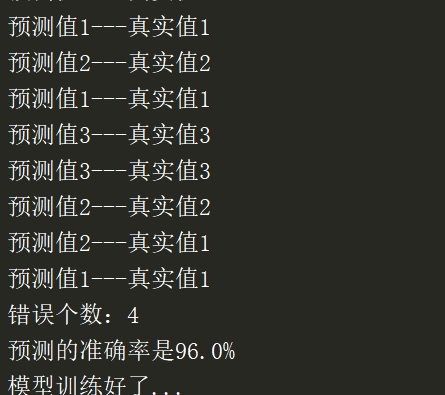每日一题 为了工作 2020 0430 第五十九题
1 2 3 4 5 6 7 8 9 10 11 12 13 14 15 16 17 18 19 20 21 22 23 24 25 26 27 28 29 30 31 32 33 34 35 36 37 38 39 40 41 42 43 44 45 46 47 48 49 50 51 52 53 54 55 56 57 58 59 60 61 62 63 64 65 66 67 68 69 70 71 72 73 74 75 76 77 78 79 80 81 82 83 84 85 86 87 88 89 90 91 92 93 94 95 96 97 98 99 100 101 102 103 104 105 106 107 108 109 110 111 112 113 114 115 116 117 118 119 120 121 122 123 124 125 126 127 128 129 130 131 132 133 134 135 136 137 138 139 140 141 142 143 144 145 146 147 148 149 150 151 152 153 154 155 156 157 158 159 160 161 162 163 164 165 166 167 168 169 170 171 172 173 174 | # coding=utf-8import numpy as npimport operatorimport matplotlib.pyplot as pltfrom time import sleep"""数据归一化"""def autoNorm(dataSet): # 统计矩阵中每一列的最大值和最小值 maxValue = dataSet.max(0) minValue = dataSet.min(0)# 每一列最小值组成的列表 rangeValue = maxValue - minValue # 获取行数 m = dataSet.shape[0] # 先将minValue这个列表复制m行 在水平复制一次 LmSubMin = np.tile(minValue,(m,1)) # 求差值 也就是归一化公式的分子 """ Lm' = (Lm - Lmin)/(Lmax - Lmin) """ normDataSet = dataSet - LmSubMin # 复制分母矩阵 MaxSubMin = np.tile(rangeValue,(m,1)) normDataSet = normDataSet/MaxSubMin # 返回内容 归一化后的矩阵 每一列最大最小值的差值 每一列的最小值 return normDataSet,rangeValue,minValue"""读取文件内容"""def fileMatrix(fileName): fr = open(fileName,"rb") #将文件内容全部加载到内存空间中 以列表的方式存储 arrayOfLines = fr.readlines() numOfLines = len(arrayOfLines) # 创建numOfLines行3列的空矩阵 returnMat = np.zeros((numOfLines, 3)) # 存放结果的列表 classLabelVector = [] index = 0 for line in arrayOfLines: # 设置编码格式 去掉一行的首尾空格 line = line.decode("utf-8").strip() splits = line.split("\t") # 遍历每一行的元素 填充returnMat矩阵 该矩阵存放元数据 returnMat[index,:] = splits[0:3] # 向列表内追加元素 classLabelVector.append(int(splits[-1])) index += 1 return returnMat,classLabelVectordef classifyData(normData,dataSet,labels,k): # normData 用来测试的样本 # dataSet 计算每一个测试样本中的数据到余下所有数据每一行的举例 # labels 余下测试样本的标签 # k 选取几个数据进行判定 dataSetLineNum = dataSet.shape[0] # 对于每一行的数据都要分别计算该行到dataSet的其余行的空间举例,所以将normData的数据进行复制 normCopy = np.tile(normData,(dataSetLineNum,1)) diffMat = normCopy - dataSet """ 距离公式是dis = {(x1-y1)^2+(x2-y2)^2+...+(xn-yn)^2}^0.5 """ SqrtDiffMat = diffMat ** 2 # 对每一行求和 sumDistances = SqrtDiffMat.sum(axis=1) # 开方获取最终的欧几里得距离 distance = sumDistances ** 0.5 # 对矩阵有小到大排序 最终返回的是矩阵元素的下标索引 sortIndex = distance.argsort() classCount = {} # 存储每一种类别出现的次数 相当于map for i in range(k): # sortIndex 里面存储的是距离当前行欧氏距离最小的那一行所在的元数据中的下标索引位置 # labels 是元数据中每一列的真实类别 voteLabels = labels[sortIndex[i]] # 相同的类别进行计数统计 classCount[voteLabels] = classCount.get(voteLabels,0)+1 # sort排序 最终返回一个list集合 sortClassCount = sorted(classCount.items(),key=lambda x:x[1],reverse=True) # sortClassCount中的数据结构 [[],[],[]] return sortClassCount[0][0]def datingClassTest(): rate = 0.1 path = "dating.txt" # 将数据划分为矩阵 dataMat, dataLabel = fileMatrix(path) # 将数据进行归一化处理 normMat,rangeValues,minValues = autoNorm(dataMat) m = normMat.shape[0] # 行号 # 将数据集按照比例进行划分 取出一部分用作训练样本集 numTestLines = int(m * rate) errorCount = 0 for i in range(numTestLines): # 第i行的所有列的数据 lineMessages = normMat[i,:] # 第normMat - m 行的所有列的数据 remainMessages = normMat[numTestLines:m,:] # 第normMat - m 行的数据类别 remainLables = dataLabel[numTestLines:m] classify = classifyData(lineMessages,remainMessages,remainLables,4) print("预测值{0}---真实值{1}".format(classify,dataLabel[i])) if classify != dataLabel[i]: errorCount += 1 print("错误个数:{0}".format(errorCount)) errorRate = errorCount/numTestLines trueRate = 1-errorRate print("预测的准确率是{0}%".format(100*trueRate)) return 1 - errorRatedef classifyPerson(): resultList = ["A","B","C"] path = "dating.txt" inputData = [18888,2,0.33] datMat,dataLabel =fileMatrix(path) normMat,rangeValue,minValue =autoNorm(datMat) autoInput = (inputData - minValue)/rangeValue result = classifyData(autoInput,normMat,dataLabel,3) print("预测的结果是:"+resultList[result-1])def createScatterDiagram(): path = "dating.txt" dataMat,dataLabels = fileMatrix(path) type1_x = [] type2_x = [] type3_x = [] type1_y = [] type2_y = [] type3_y = [] # 生成一个新的图像 fig = plt.figure """matplotlib下,一个figure图像可以包含多个子图axes""" # subplot(numRows,numCols,plotNum)图表的整个绘图区域被分成numRows行和numCols列 # 按照从左到右,从上到下的顺序对每个子区域进行编号,左上的子区域编号为1 # plt.subplot(111)等价于plt.subplot(1,1,1) axes = plt.subplot(111) # 设置字体 plt.rcParams["font.sans-serif"]=["SimHei"] index = 0 print("-----") for i in range(len(dataLabels)): if dataLabels[i] == 1: type1_x.append(dataMat[i][0]) type1_y.append(dataMat[i][1]) if dataLabels[i] == 2: type2_x.append(dataMat[i][0]) type2_y.append(dataMat[i][1]) if dataLabels[i] == 3: type3_x.append(dataMat[i][0]) type3_y.append(dataMat[i][1]) # 绘制散点图 前两个参数表示相同长度的数组序列 s表示点的大小 c表示颜色 type1 = axes.scatter(type1_x,type1_y,20,"red") type2 = axes.scatter(type2_x, type2_y, 40, "green") type3 = axes.scatter(type3_x, type3_y, 50, "blue") plt.title("标题") plt.xlabel("水平横轴") plt.ylabel("竖直纵轴") # loc 设置图列位置 2是upper left axes.legend((type1,type2,type3),("A","B","C"),loc=2) plt.show()if __name__ == '__main__': print("训练开始了...") createScatterDiagram() sleep(5) # 训练数据 acc = datingClassTest() if acc > 0.9: print("模型训练好了...") # 测试数据 classifyPerson() |





【推荐】编程新体验,更懂你的AI,立即体验豆包MarsCode编程助手
【推荐】凌霞软件回馈社区,博客园 & 1Panel & Halo 联合会员上线
【推荐】抖音旗下AI助手豆包,你的智能百科全书,全免费不限次数
【推荐】博客园社区专享云产品让利特惠,阿里云新客6.5折上折
【推荐】轻量又高性能的 SSH 工具 IShell:AI 加持,快人一步
· 开发中对象命名的一点思考
· .NET Core内存结构体系(Windows环境)底层原理浅谈
· C# 深度学习:对抗生成网络(GAN)训练头像生成模型
· .NET 适配 HarmonyOS 进展
· .NET 进程 stackoverflow异常后,还可以接收 TCP 连接请求吗?
· 本地部署 DeepSeek:小白也能轻松搞定!
· 基于DeepSeek R1 满血版大模型的个人知识库,回答都源自对你专属文件的深度学习。
· 在缓慢中沉淀,在挑战中重生!2024个人总结!
· 大人,时代变了! 赶快把自有业务的本地AI“模型”训练起来!
· Tinyfox 简易教程-1:Hello World!